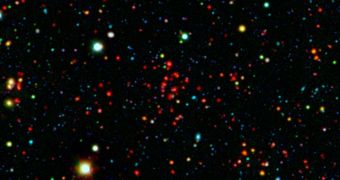A team of astronomers operating the NASA Spitzer Space Telescope determined in a new study that galactic clusters began looking desolate a long time ago. The work also shows how these huge objects appeared and evolved when the Universe was in its earliest stages.
Our Cosmos is estimated to be around 13.75 billion years old. Less than a billion years after the Big Bang occurred, galaxies and stars were already forming at a frantic pace, and some of these objects congregated in stellar or galactic clusters. These formations grew at fast rates over prolonged periods.
However, most old clusters have since lost their splendor, and now look like ghost cities, and researchers at University of Missouri-Kansas City were curious to learn why. The research was led by astronomer Mark Brodwin, and published in the latest issue of the Astrophysical Journal.
The reason why galaxy clusters grew so fast is that they tended to have vast volumes of cold molecular hydrogen gas available for stellar formation. However, around 9 billion years ago, these clusters simply stopped producing new stars, and started turning into shadows of their former selves.
Data from Spitzer, the NASA/ESA Hubble Space Telescope and the W.M. Keck Observatory were used to collect clear images of very distant clusters. These telescopes found that clusters either lost, or fully consumed, their fuel reserves by 4.75 billion years after the Big Bang.
Interestingly, galaxies that have not made their way into clusters or superclusters by this point tend to exhibit higher stellar formation rates than their neighbors living in groups.
“We know the cluster galaxies we see around us today are basically dead, but how did they get that way? In this study, we addressed this question by observing the last major growth spurt of galaxy clusters, which happened billions of years ago,” Brodwin explains.
The research effort was concentrated on 16 distant galaxy clusters, which permeated the Universe between the ages of 4.3 and 6 billion years old. Spitzer's infrared detectors were used to detect new stars forming within these distant structures.
“We find that around 9 billion years ago, cluster galaxies were as active as their counterparts outside of clusters; however, their rate of star formation decreases dramatically between then and now, much more quickly than we see in isolated galaxies,” says Stacey Alberts.
The expert, who is based at the University of Massachusetts-Amherst, recently published a second study on the same topic, in the Monthly Notices of the Royal Astronomical Society. His research paper is based on data gathered by the European Space Agency's Herschel Space Observatory.
“It's as if boom times for galaxies in clusters ended with a sudden widespread collapse. They go from vibrantly forming new stars to the quiescent state they've been in for the last half of the history of the universe, and the switch happens surprisingly fast,” comments Peter Eisenhardt.
The expert, who holds an appointment with the NASA Jet Propulsion Laboratory (JPL), in Pasadena, California, was the leader of a previous investigation that managed to identify the 16 distant clusters the two new papers focused on.

 14 DAY TRIAL //
14 DAY TRIAL //